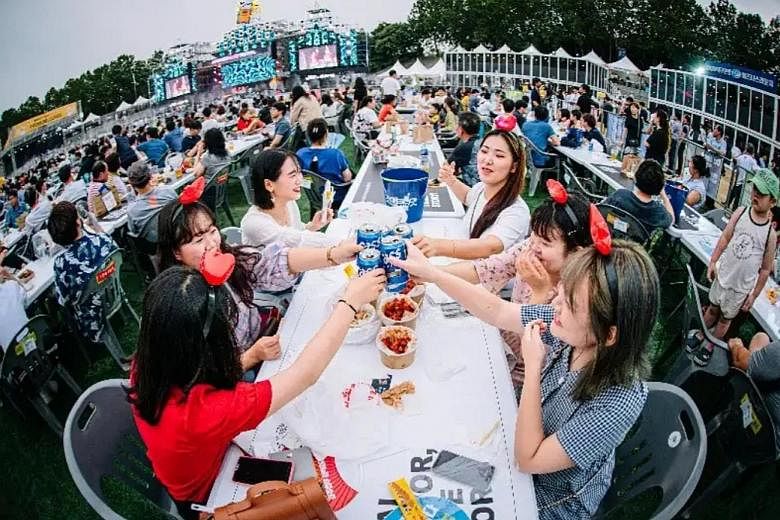Call it chimaek diplomacy.
The combination of fried chicken with maekju or beer in Korean - hence chimaek - that has shot to global fame on the raging popularity of Korean Wave is now being used to deepen friendship between two leaders.
After Singapore Prime Minister Lee Hsien Loong left Seoul last month, South Korean President Moon Jae-in tweeted him an invitation to "try some of Hongdae's street food and some fried chicken over a few beers the next time you're here".
It had come to his attention that Mr Lee, who was here to attend the Asean-Korea Commemorative Summit, had popped by the vibrant university town of Hongdae and enjoyed chimaek there.
PM Lee replied on Twitter: "Look forward to taking up your offer the next time I am in Korea!"
Korean fried chicken - known to be one of the crispiest and most flavourful recipes for chicken in the world - is now a billion-dollar business with over 400 brands and nearly 87,000 stores feeding South Korea's population of 50 million.
This is an increase from the 36,000 stores in 2015, and far exceeds the 38,000 McDonald's outlets worldwide.
Dozens of exciting flavours abound - from garlic soy and honey glazed to spicy pepper, curry and "snow cheese" - and stores will deliver anywhere, even to a park. One order - about one chicken, cut up in portions - costs around 16,000 won (S$18).
Ms Lee Hoo-do recalls getting as many as 10 fliers for chimaek when she was at the riverside Hangang Park. "There's a delivery spot nearby and the delivery man will call when he arrives. Some even give free picnic mats," the 23-year-old intern told The Straits Times.
"I've never heard anyone say they don't like chicken," she added. "The refreshing taste of bubbly beer goes really well with the greasiness of fried chicken. It's comfort food for everyone."
So how did chimaek come about?
Observers said it was born out of the 2002 World Cup fever, when the South Korean team made it to the semi-finals for the first time. People gathered at pubs to watch the match over chicken and beer.
There were only about 10,000 chicken eateries then, and the number tripled after a decade.
The global craze, however, was fuelled by the power of the K-wave, most notably the 2014 drama series My Love From The Star, which saw the female protagonist craving chimaek when it snowed.
The show was so popular in China that it sparked a chicken with beer craze there and drew thousands of tourists to South Korea for chimaek parties. It spilled over to the area of diplomacy, with government officials of both countries joining each other's beer festivals until bilateral relations soured in 2016 over a missile shield row.
Back in South Korea, an annual chimaek festival has been taking the country by storm.
Held every July, the Daegu Chimac Festival grew from a three-day event that drew 270,000 people in 2013 to a five-day bonanza that now attracts more than a million visitors. Chimac is an alternative spelling for chimaek.
Daegu city is home to many of South Korea's poultry farms. It is also the birthplace of major fried chicken chains that tweaked the recipes first brought by American troops dispatched to the country during the 1950-1953 Korean War.
In 1978, a Daegu restaurant introduced a seasoned spicy chicken that became a hit and paved the way for it to expand into one of the country's largest brands, Mexican Chicken.
Many others followed suit, especially after witnessing the popularity of American chain Kentucky Fried Chicken, which entered South Korea in 1984.
The most successful is Kyochon Chicken, whose 1,037 franchise stores achieved 318 billion won in sales last year.
Given the stiff competition, industry experts are worried about market saturation and warn of challenges ahead. Last year alone, 6,200 new fried chicken stores opened, but 8,400 shut down. Several chains have had to venture overseas in a bid to expand.
There are also concerns about health.
Ms Kim Ga-eun, 24, lamented that the joy from eating chimaek is short-lived. "I have regrets after eating because the calories are extremely high," said Ms Kim, who works in a tour company.
Office worker Seo Yong-hyun, 26, said his dermatologist advised him to stop eating chimaek, but "it's much easier to order chimaek than to cook something myself".
On the diplomacy front, though, chimaek may continue to shine.
Dr Lee Jae-hyon of the Asan Institute for Policy Studies, an expert on South-east Asia, feels that chimaek diplomacy is a good idea.
He said President Moon - who ate chimaek with locals in a Seoul pub in July last year - can probably enjoy this kind of casual meeting with Singapore's PM Lee or other Asian leaders.
PM Lee and Mr Moon have held two bilateral summits and met at several multilateral summits in the past 21/2 years, such as the Group of 20, Asia-Pacific Economic Cooperation and Asean+3.
"It would be good for the two leaders to sit at an outdoor table instead of a boring meeting room," Dr Lee told The Straits Times.
"Moon's style of diplomacy is not just about suits and microphones, but also non-conventional areas such as chimaek, which will bring the distance between the two countries and its people closer."

